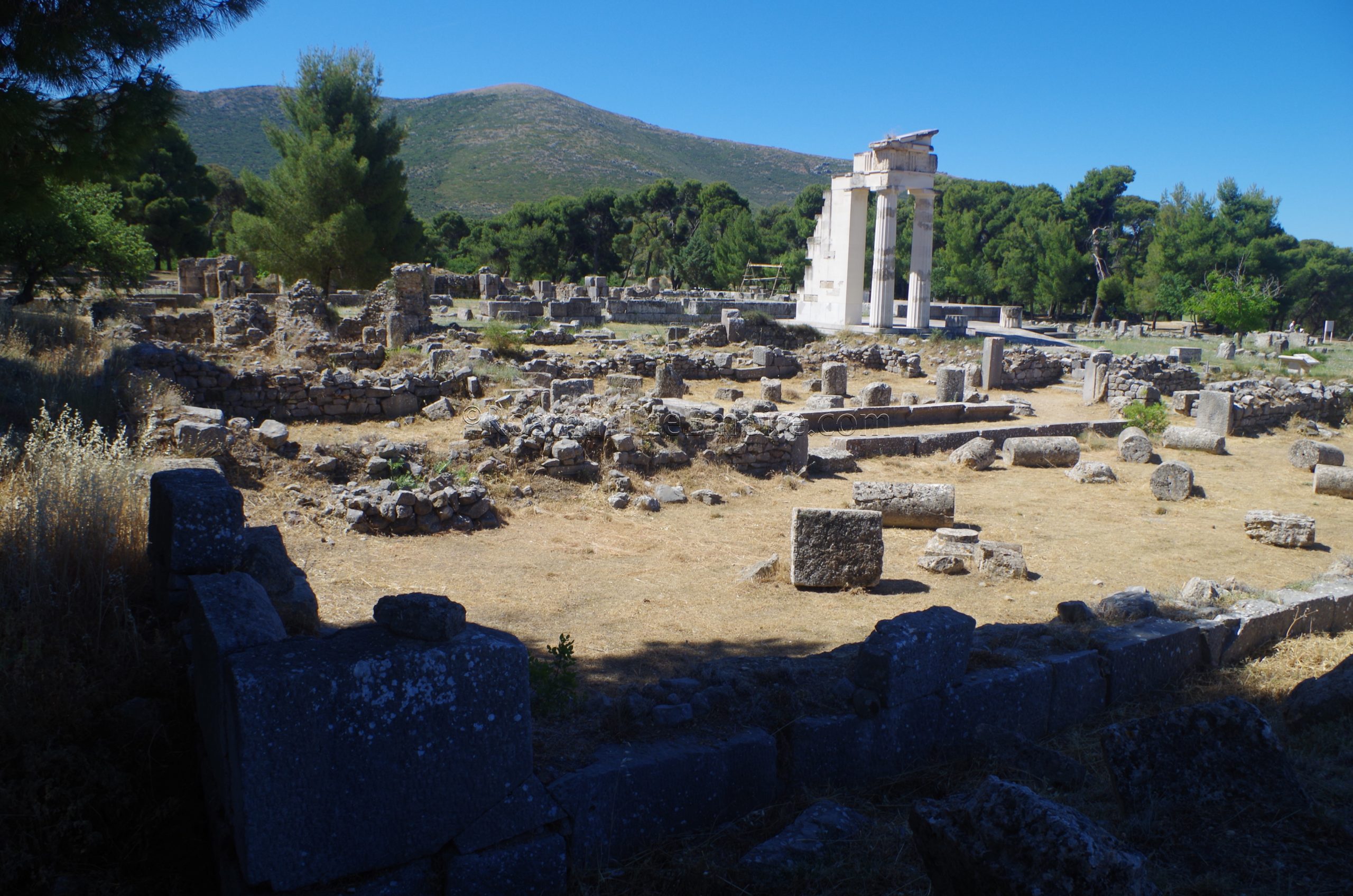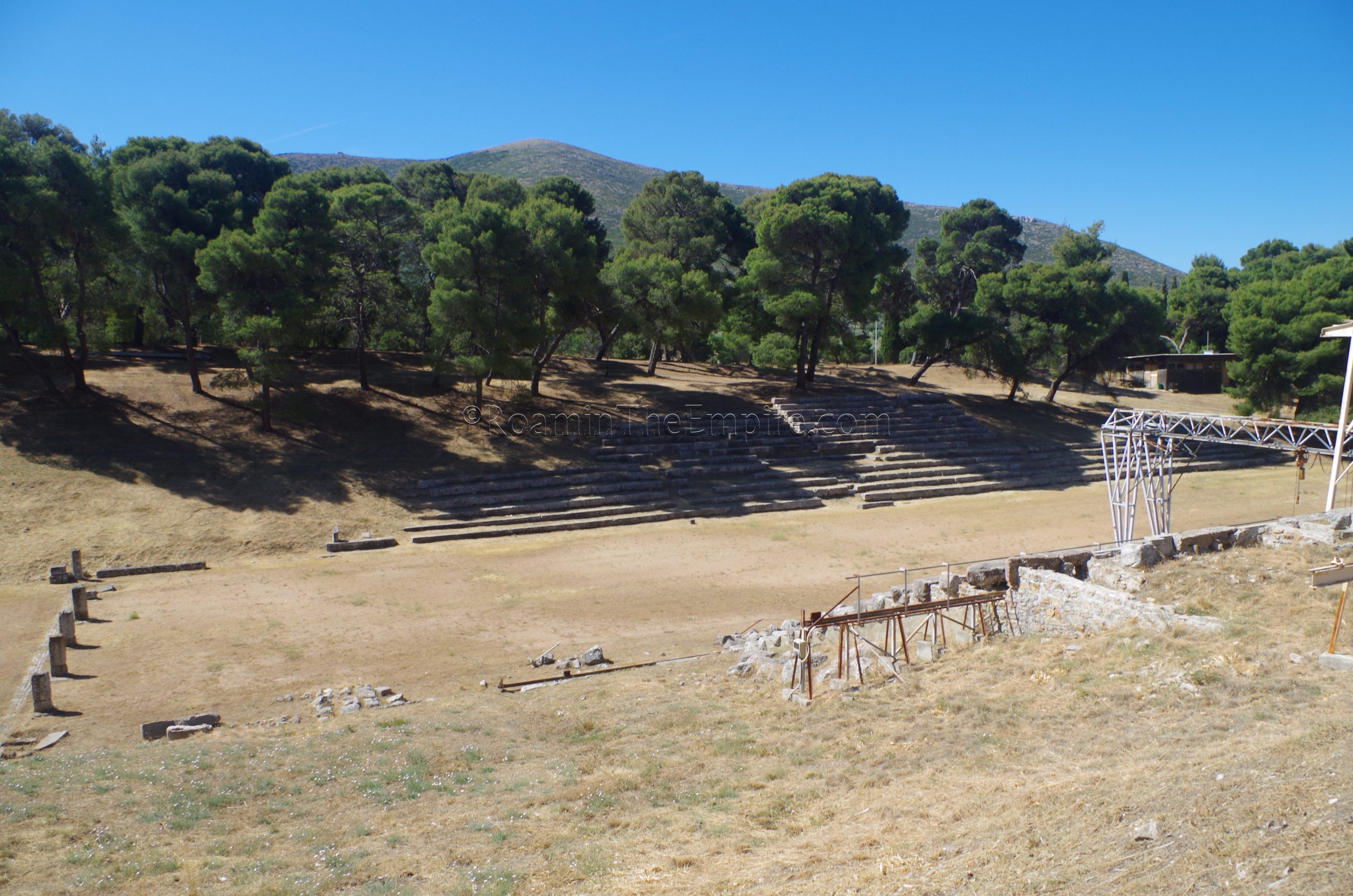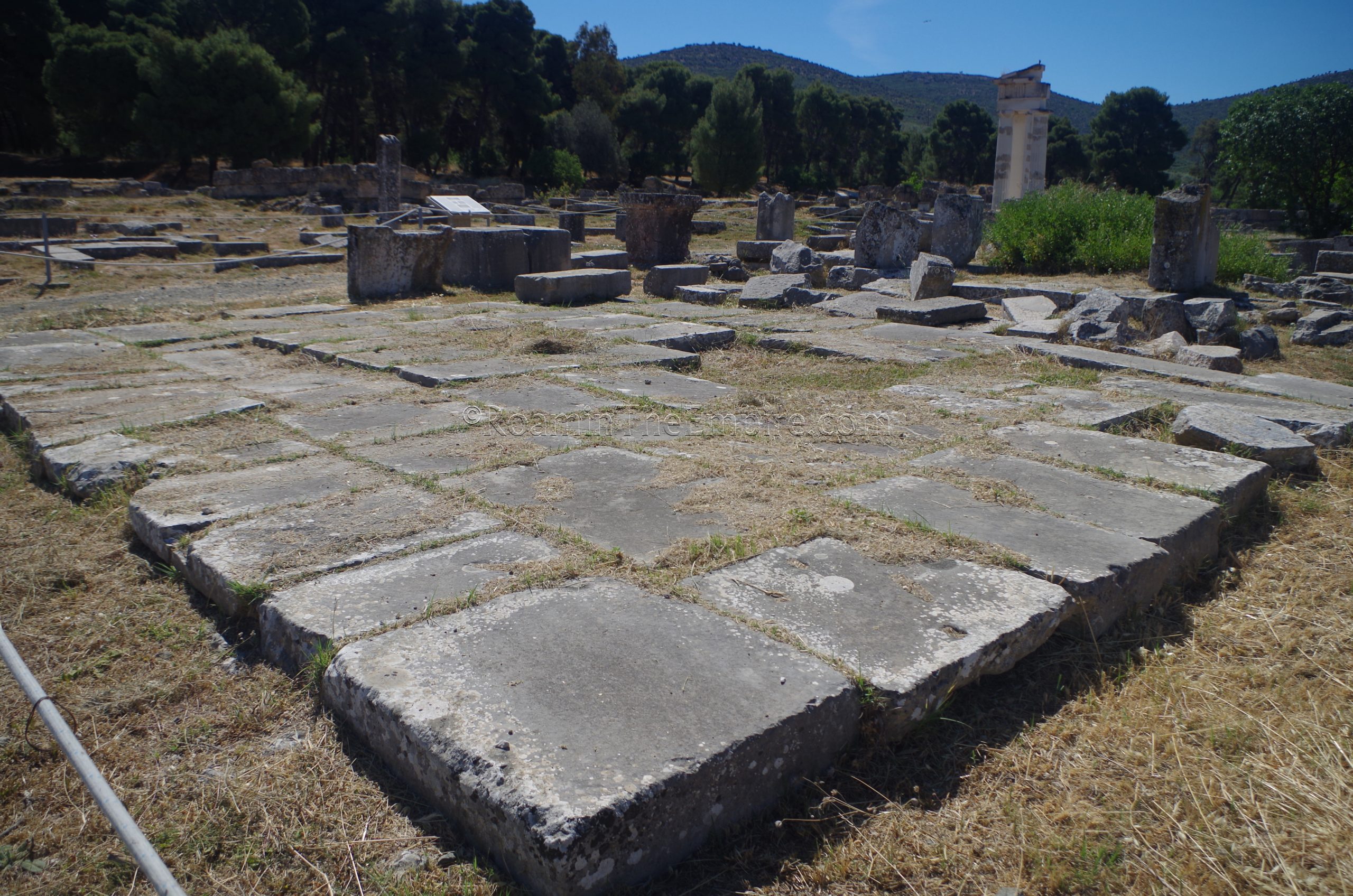
Continued From Sanctuary of Asclepius Part I
Heading west from the Katagogion, one comes to the southern area of the actual sanctuary. The southernmost of these buildings is the Greek baths. These were constructed around 300 BCE and were fed from a spring on Mount Kynortion. The baths likely served a religious purpose in providing a means of ablution as well as a practical therapeutic purpose in the treatment of the sick. During the Roman period, additional pools and reservoirs were added to the building, which can be seen in the eastern part of the structure. These baths are sometimes thought to be those described by Pausanias as having been constructed by a Roman senator named Antoninus in the 2nd century CE, though that may be referring to another bathing complex elsewhere in the site.
Most of the outline of the baths is preserved in a single course of stone wall, though much of the south wall survives with a second course. It is thought to have had a second story. Unlike the more elaborate Roman style baths, these consisted mostly of a courtyard surrounded by rooms in with bathing basins were placed; particularly on the north and west side, while the south and eastern rooms seemed to serve some other ancillary purpose. Some elements of hydraulic channels can be seen as well.

Just to the north of the Greek baths is the Hestiatorion complex. Constructed around 300 BCE, the Hestiatorion was a ceremonial building that housed ritual meals that were undertaken in the cult of Asclepius. Burnt food remnants found in the eastern part of the building seem to indicate the sacrifice of food to the god while his worshippers communally consumed the remains. The southern part of the building also seems to have elements that may have served as a sort of gymnasium area. The western part of the Hestiatorion was destroyed during Cilician pirate raids around 67 BCE. In the 2nd century CE, the central courtyard was replaced by an odeon, in which it is believed musical performances related to the games or festivals were held.
A monumental entranceway to the complex, the propylon, was converted into a temple to Asclepius’ daughter Hygeia during the Roman period. Perhaps again in the 2nd century CE when tertiary entrance to the complex was constructed in the southeast corner. The remains of the propylon temple on the north side of the Hestiatorion is notable for the two reconstructed columns that make it one of the most high profile monuments at the site. An altar to Hygeia still remains outside it. The Hestiatorion itself is not accessible and only visible from points around the exterior wall of the building. Shops were also constructed outside the Hestiatorion to the west of the propylon temple during the Roman period, as well as a stoa and some baths on the east side, though neither sets of constructions are very well preserved or visible. Perhaps one of the better views into the complex of the Hestiatorion is from a rise along the east side of the structure.

Continuing toward the north, the next building is the Sanctuary of the Egyptian Gods. This building is also noted as being part of the building program of the senator Antoninus in the 2nd century CE. This is believed to be the temple to Hygeia, Asclepius, and Apollo that is noted by Pausanias, with the latter two being worshipped as Egyptian gods. In fact, it seems as though Hygeia was also worshipped as Isis, with Asclepius and Apollo in the roles of Horus and Osiris, respectively.
The square shaped building is essentially open access, one can walk around freely in it. There is an entranceway on the west side of the building that leads into a central hall/courtyard area. Along the north side are stone benches, and a stone seat and offering table is located in the northeast corner of this central area. The north side of this central hall also apparently contained an offering pit, though I couldn’t find any physical remains. The northern part of the building contained a gathering hall, while the southern part a number of rooms assigned various purposes, including spaces for initiations into mystery rites. The most interesting of these is in the southeast corner, a circular room with walls presently surviving/reconstructed to a significant height. This circular room contained a lustral basin for ablution rituals.

Located kitty-corner to the northwest corner of the Sanctuary of the Egyptian Gods is a temple dedicated to Artemis. The small temple was, in particular, dedicated to the aspect of Artemis tied to Hecate. The temple itself seems to have been constructed in the late 4th century BCE, though there is evidence of her cult in the sanctuary dating back to at least the 5th century BCE. Elements of the architecture from this temple have been found re-used in later Roman constructions, perhaps indicating that the temple had fallen out of use by that time.
The temple itself is roped off, which is probably for the best. It’s rather small, so there’s not much that could be gained by allowing direct access. The temple is oriented facing toward the east, but it’s pretty difficult to see this from the ground. A block on the north side supposedly bears an inscription of the goddess’ name, though I couldn’t make out the inscription when I visited. Some elements of the temple are displayed in the on-site archaeological museum, including part of a column, some of the entablature, and roof tiles with acroteria in the shape of boar and dog heads, animals associated with Artemis.

About 75 meters to the southwest of the Temple of Artemis is the ancient stadium of the sanctuary. The first incarnation of the stadium seems to have been constructed in the 5th century BCE, making use of a natural depression to support the seating. The seating originally consisted of less robust seating made with clay and stone, but in the 4th or 3rd centuries BCE, more permanent stone block seating, the seating present today, was added. The stadium hosted footraces and also had areas for jumping, wrestling, and boxing events that were held in conjunction with the Asklepia games.
There is no real access to the stadium, presently. It is really only viewable from the east end. Access along the north and south sides has been roped off (unless you accidentally wander into the north side area from the Isis sanctuary and baths in the northwest part of the site), and direct access to the stadium is not allowed. Part of this seems to be due to ongoing restoration on the seating on the north side, and perhaps the entrance tunnel as well. There’s some sections of seating visible on the south side as well, as are the stone posts that formed the starting line of the track area. Also off limits without any kind of access or visibility is the gymnasium to the north/northwest of the stadium; where the athletes prepared for their competitions and which was connected to the stadium via the previously mentioned entrance tunnel.

Heading to the north/northeast of the stadium is the core of the sanctuary complex, where some of the most important buildings were located. The southern part of this is situated roughly next to the previously discussed Temple of Artemis, in an irregularly shaped area between some intersecting paths. The very south of this little patch of remains were some more Roman era shops, which would have been opposite the shops that were located west of the propylon temple, and together would have helped form a little open square bounded by the propylon temple, Temple of Artemis, and Sanctuary of the Egyptian Gods. North of these shops were the oikoi, the treasuries associated with the sanctuary that were dedicated by various municipalities, though there do not seem to be any specific identifications with the treasuries at Epidaurus. These were constructed in the 4th century BCE. The area is roped off and there is no access, and most of the treasuries are set back from the path while not being preserved to a very high level, leaving little to see for the visitor.
At the northeastern corner of this area, much more visible due to its location close to the visitors’ paths, is a robust stone structure; a rectangular feature that essentially looks like a paved area. This was an altar to Apollo, originally dating to the 6th century BCE and associated with the adjacent structure to the east, the so-called Building E. While the structure standing today dates to the Hellenistic and Roman period, the area itself seems to have been an important part of the cult center dating back to the 6th century BCE. Evidence suggests that it was a space where offerings were made to both Asclepius and Apollo, and in which communal meals were conducted among worshippers. At the center was an open air altar surrounded on three sides with porticoes, and in the northwest part of the complex was a small shrine. As the popularity of the cult here increased, the Hestiatorion was built in order to serve roughly the same function, but which could accommodate the greater number of worshippers. Parts of the ritual continued to take place in Building E, though.

In the Hellenistic and Roman periods, Building E occupied the same footprint as the earlier structures, but was restored and embellished. A water channel was constructed through the middle of the central courtyard in the Roman period to assist with the cleaning of the area. Once again, direct access within the structure is prevented by the entire area being roped off. On the north side of Building E are a few of the Greek exedrae seats with some remaining inscriptions. The second from the east is the oldest at the sanctuary, dating to the mid to late 4th century BCE and dedicated by Aristarchos, a priest of Asclepius.
Heading back to the west is the circular structure alternatively referred to as the Tholos or the Thymele. The identification of the structure as a Tholos comes from Pausanias’ description of the site, noting also that this building, like the theater, was built by the architect Polykleitos the Younger. The exact nature of the use of the building is not readily. One interpretation, heavily suggested by Pausanias’ identification, is that it was representative of the underworld dwelling of Asclepius, who was killed by Zeus for one of a variety of reasons according to different accounts. The he was later resurrected, some descriptions having him continue to heal the sick from his place in the underworld. The discovery of expense reports related to the construction of the building, however, record it as being the Thymele, which suggests it was an altar of some sort. Still, another interpretation states that it may have been some sort of musical performance venue, perhaps connected to healing rituals. The building seems to have been constructed in the 4th century BCE.

Unfortunately, the Tholos/Thymele is presently covered in scaffolding. At least, the front part of it is. It seems to be part of some sort of works to reconstruct some of the columns. There is a point where one can see around the scaffolding, but there isn’t a whole lot to see with regard to where the interior of the construction would have been. Like many of the monuments, barriers keep anyone from getting very close, and consequently not getting a very good look at what is going on aside from the most visible parts of the exterior structures.
North of the Tholos/Thymele structure is the Enkoimeterion, also known as the Stoa of Abaton. This structure was where the ill pilgrims would stay in order to receive healing from Asclepius. Records of miraculous cures were kept here as well, some of which are now housed in the museum. This was a process known as incubation, or enkoimesis, which gives the structure one of its names. The structural similarity to a stoa, and the fact that it was off limits to those who had not performed the necessary rituals to receive healing from Asclepius, and was therefore impenetrable (abaton) to others, leads to the second name. The eastern upper portion of the building was constructed in the early 4th century BCE, while a lower level was added, making use of the natural slope, in the late 4th century BCE. The older upper portion was the site of the earliest enkoimesis in the 6th century BCE, taking place in an open area near the sacred near the southeastern part of the building. The well remained in use, and the upper part of the Enkoimeterion was used for ritual cleansing, while the lower part was where the ill actually received the healing from Asclepius.

The Enkoimeterion has a pretty good level of access. There is not much in the upper part aside from some reconstructed columns, but one can take stairs down to the lower portion and into the building where the sick would wait for healing. This area has also been reconstructed to some degree. Some remains of a Roman era addition are visible extending to the west from the main part of the lower level, though they are quite fragmentary. They are not directly accessible either, as there are barriers preventing visitors from going any farther west.
Continued in Sanctuary of Asclepius Part III
Sources:
Elsner, Jas and Ian Rutherford. Pilgrimage in Graeco-Roman & Early Christian Antiquity: Seeing the Gods. New York: Oxford University Press, 2005.
Grant, Michael. A Guide to the Ancient World: A Dictionary of Classical Place Names. New York: Barnes & Noble Books, 1997.
Kristensen, Troels Myrup. “Mobile Situations: Exedrae as Stages of Gathering in Greek Sanctuaries.” World Archaeology, Vol. 50 No. 1, 2018, pp. 86-99.
Pausanias. Hellados Periegesis, 2.26.7, 2.27, 9.7.5.
Schultz, Peter and Bronwen L. Wickkiser. “Communicating with the Gods in Ancient Greece: The Design and Functions of the ‘Thymele’ at Epidauros”. The International Journal of Technology, Knowledge and Society, Vol. 6 No. 6, 2010, pp. 143-164.
Smith, William. Dictionary of Greek and Roman Geography. Walton & Murray, 1870.
Stillwell, Richard, William L. MacDonald, and Marian Holland. McAllister. The Princeton Encyclopedia of Classical Sites. Princeton, NJ: Princeton U Press, 1976.


